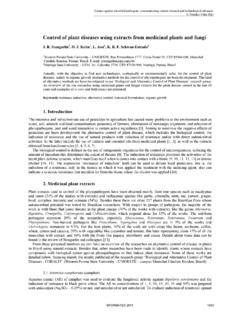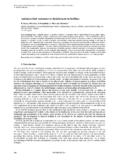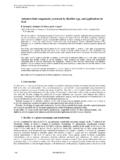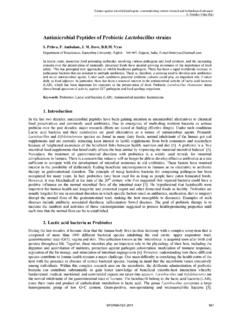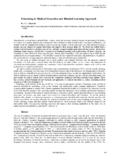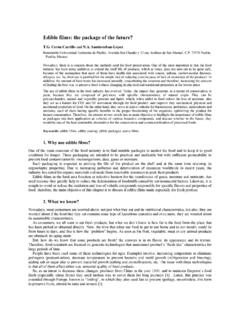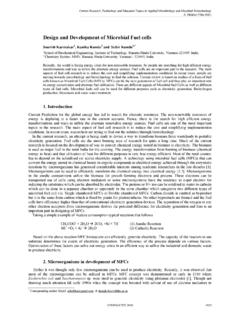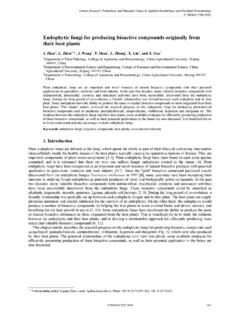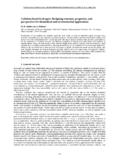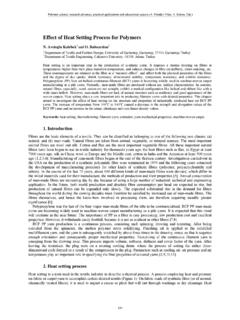Transcription of Microscope maintenance and quality control: A practical …
1 Microscopy: advances in scientific research and education (A. M ndez-Vilas, Ed.). _____. Microscope maintenance and quality control : A practical guide Brady Eason1,2,*, David Young1,*, Aleksandrs J. Spurmanis1,3, Tse-Luen (Erika) Wee1, Daniel Kaufman4. and Claire M. Brown1,4,5. 1. McGill University Advanced BioImaging Facility (ABIF), 2. Currently at University of Western Ontario Dental School, 3. Currently a Technical Representative, Nikon Canada Inc., 4. Department of Physiology, 3649 Prom Sir William Osler, Bellini Building, Rm137a, McGill University, Montreal, Quebec, Canada H3G 0B1. 5. Corresponding author *. Equal contribution by both authors Since their inception in the 17th century, light microscopes have evolved from qualitative documentation tools into sophisticated instruments capable of providing quantitative spatial and temporal information.
2 As the light Microscope has evolved, so have the demands of researchers in addressing scientific questions. Simply observing a specimen is not enough: there is a need for increasingly precise and accurate information to enable quantitative and reproducible microscopy experiments. In order to perform quantitative microscopy there is a need to ensure that the Microscope performance is optimal and consistent. Here we present a concise, but detailed set of methods that are easily adaptable to a variety of equipment designs and configurations. This flexibility is useful in circumstances where a variety of instruments are to be monitored within tight time constraints in order to benchmark microscopes and ensure stable performance over time.
3 This guide combines work from previously described tests and analytical tools, outlines published protocols and introduces new procedures in the context of maintaining, troubleshooting and addressing instrument performance problems [1-6] ( ). The procedures described include methods for: 1) inspecting, cleaning and maintaining the optical and mechanical components of the Microscope stand; 2). monitoring the performance of ancillary equipment such as anti-vibration tables and live-cell incubators; 3) measuring objective lens quality and instrument resolution using point spread function (PSF) imaging, analysis and quality metrics [1]; 4) testing instrument alignment and field illumination uniformity [4]; 5) monitoring light source stability over the short, moderate and long term [4]; 6) testing light source linearity and power using a power meter; 7) testing co- registration of imaging channels for accurate co-localization between the various channels for multi-color samples [4].
4 Image processing and analysis of the resulting data can be conducted using open-source software and plug-ins for ImageJ. that are readily and freely accessible to the scientific community [2], however MetaXpress and Microsoft Excel were used extensively for the analysis presented here. quality assurance assessments are described using a systematic five-step format of: (a) experimental rationale, (b). description of experimental methods, (c) illustration of representative results, (d) interpretation of results, and (e) potential corrective measures. The procedures are useful for researchers new to microscopy, independent research laboratories, centralized core facilities and seasoned microscopists.
5 Careful implementation of the procedures will help ensure optimal instrument performance and the generation of the highest quality scientific data. Keywords: Microscope ; fluorescence; confocal; quality control ; maintenance ; quantitative; resolution; alignment; co- localization; signal-to-noise 1. Microscope stand maintenance Optimal image formation relies on the proper functioning of the optical and mechanical components within the Microscope stand. The most common issue with optical surfaces along the optical light path is dirt and dust. Dirt and dust cause artifacts within both the image plane and the out-of-focus planes. Gloves should be worn when performing the procedures below to avoid skin oils from contaminating the optics.
6 The use of checklists and/or log sheets is encouraged in order to maximize the efficiency of workflow and to ensure that inspections are conducted and documented in a consistent manner. Sample checklists and worksheets are available for download from the Advanced BioImaging Facility webpage ( - under the resources tab). Transmitted light path maintenance of optical surfaces: Contaminants on brightfield condenser filters ( blue correlation filters, polarization filters), DIC filters and prisms, and glass windows on fluorescent filter cube turrets can be cleaned in several ways. The first and least invasive step is to remove contaminants using a puff-duster (Giotto's Industrial Inc.)
7 , Rocket-air). Do not use pressurized air canisters as they contain volatile organic aerosols that can contaminate, and even damage, sensitive optical surfaces [7]. When contaminants are more difficult to remove, use clean room swabs (CB-FS751B - ) or swabs prepared by wrapping 100% pure cotton wool around a wooden applicator. Prepared FORMATEX 2014 713. Microscopy: advances in scientific research and education (A. M ndez-Vilas, Ed.). _____. cotton swabs ( Q-tips ) should be avoided as they may contain synthetic fibers and other inclusions that can abrade optical surfaces [7]. Minimal contact pressure and duration are recommended when wiping, beginning from the center of the optical element and moving outward in a spiral motion so that particles are directed toward the edges.
8 Ammonia- free lens cleaner diluted 1:5 in de-ionized water can be applied to surfaces contaminated by strongly adherent particles or stains ( SparkleTM, GlassPlusTM). Swabs should only be used once in order to prevent re-introducing contaminants back onto the optical surface. A second cleaning of the objective lens with distilled water is recommended to clean off any deposits left by the lens cleaner. Organic solvents and detergents containing ammonia ( WindexTM) should be avoided as these can degrade filter coatings. Reflected light path Fluorescent light source Many modern light sources for fluorescence microscopy are alignment free. However, older mercury vapor arc lamps must be properly aligned to avoid shading artifacts within fluorescence images.
9 Alignment needs to be conducted after each bulb change. Move to an open position in the objective lens turret and remove the dust cap. If an open position is not available, remove one of the objective lenses. Place a white piece of paper or a business card on the Microscope stage. Attenuate the mercury arc lamp or move to a red filter cube to avoid any remote chance of eye exposure to damaging UV light. An image of the arc and its reflection will be seen on the white paper. The image of the arc can be aligned to the center of the objective lens opening using adjustment screws on the lamp housing. The reflected image of the arc should be aligned in the center of the objective lens opening, but slightly shifted to the left or to the right of the image of the arc.
10 This alignment is done using the setscrews on the lamp housing for the reflecting mirror inside. Figure 1a shows a mercury lamp alignment tool with the image of the arc and the reflection well-focused and side-by-side. ND filters The incorporation of neutral density (ND) filters is recommended to attenuate the incident light from high intensity arc lamps. This will reduce photo-damage to fixed samples and photo-toxicity to live samples during sample observation or imaging [8] ( ). Most research-grade microscopes provide a place in the fluorescence light path to insert a slider containing one or more neutral density filters ( 1% and 10% ND. filters). Routine care and inspection of these filters is performed as described in Section Reflector filters and mirror maintenance Inspect filters and mirrors within reflector cubes for contaminants.
